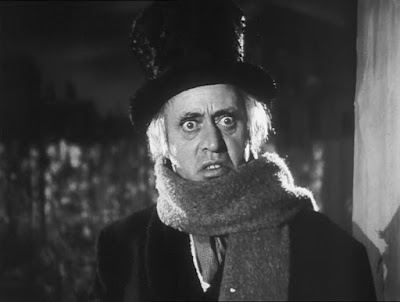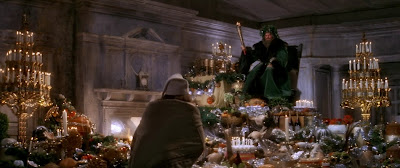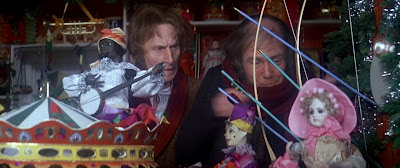Scrooge
Black-and-white feature film
United Kingdom
George Minter Productions
1951
87 minutes
Victorian
The first major British version of A Christmas Carol since 1935’s Scrooge, this version from sixteen years later appears to be influenced by the 1930s effort, and not simply through having the same title. There are particular sequences – not ones featured in the book – which seem to have been inspired by the 1935 version.
Cast and crew:
Director Brian Desmond Hurst was an Irishman, born in Belfast, and has been acclaimed as one of the most successful film directors to have come from that island. A veteran of the First World War, where he’d fought at Gallipoli, Hurst had moved to Hollywood in the 1920s where he’d learned the filmmaking craft from noted director John Ford. He moved back across the Atlantic to London in the early 1930s where he went on to work with Alexander Korda. He directed over twenty films, although Scrooge is probably the best-remembered of his work today.
Scriptwriter Noel Langley was a South Africa, although he later became a naturalised American
citizen. He’d moved to the UK after graduating from university in the early
1930s, where he became a playwright and novelist, before making the move to
Hollywood towards the end of the decade. There he was one of the co-writers of
one of the most famous feature films ever made, The Wizard of Oz. After
the Second World War he returned to working in Britain, where he wrote a series
of screenplays for UK-made films, before later returning again to the USA.
Alastair Sim’s
role as Scrooge is regarded as the definitive part of his career, and although
he also had popular success elsewhere – such as in the St Trinian’s films –
it’s by far and away the role for which he is best remembered, with some
regarding him as the definitive screen interpretation of the part. Sim and his
Marley, Michael Horden, would return to their roles for Richard Williams’s animated version of the tale in 1971, with Horden eventually earning a promotion
to the Scrooge part himself when he starred in the 1977 BBC television version.
Director Brian Desmond Hurst was an Irishman, born in Belfast, and has been acclaimed as one of the most successful film directors to have come from that island. A veteran of the First World War, where he’d fought at Gallipoli, Hurst had moved to Hollywood in the 1920s where he’d learned the filmmaking craft from noted director John Ford. He moved back across the Atlantic to London in the early 1930s where he went on to work with Alexander Korda. He directed over twenty films, although Scrooge is probably the best-remembered of his work today.
Underdone Potato:
Fairly unusually, although by no means the only diversion this version will take into its own original territory, we begin with Scrooge not in his counting house, but at the exchange. Here he has a brief discussion with the two businessmen who will later be seen in the Yet-to-Come section, discussing his death.
We also see
Scrooge dismissing someone who owes him money pleading to be allowed more time,
and being dismissed with the assertion that it makes no difference what time of
year it is, and the money would still be owed if it were a hot day in August.
Fairly unusually, although by no means the only diversion this version will take into its own original territory, we begin with Scrooge not in his counting house, but at the exchange. Here he has a brief discussion with the two businessmen who will later be seen in the Yet-to-Come section, discussing his death.
When Scrooge finally
does make it back into the office and we begin to pick up the start of the book,
the order of Fred’s and the Charitable Gentlemen’s visits have been swapped
around, and indeed the latter two are already waiting for him when he arrives.
Which makes you wonder a bit about exactly what their conversation was with
Cratchit when he admitted them and allowed them to wait, as they still enquire when
Scrooge arrives whether they’re addressing him or Mr Marley.
They are
dismissed in the usual manner, with the film running pretty close to the book
for a while here, although when Fred turns up a lot of the dialogue is changed
and the exchange is shortened. Particularly, Scrooge’s disapproval of Fred
having got married is made a bit stronger, probably for reasons to do with
things we’re going to see shortly in the Christmas Past section.
 |
| As this film seems to have been influenced by the 1935 version, so it in turn would seem to have influenced the 1970 musical with this bit of Tim peering into the toyshop window |
There’s a rare
showing of Scrooge having his meal in a tavern on his way home, and a new bit
for the film gives a further demonstration of his miserliness when he calls for
more bread, the waiter tells him it’s a halfpenny extra and he dismisses the
man with a curt, “No more bread!” as if it were the waiter himself who had
suggested it.
When Marley turns
up, Horden’s performance is more on the sad and mournful side than the urgent
and accusing tone which Jacob is often given, although I wouldn’t say that either
decision was necessarily right or wrong. The Marley sequence stays very
faithful to the book, even going so far as to include the lines about the
toothpick which are hardly ever included in any other adaptations.
Past:
The Spirit doesn’t quite capture the strange, old-youngness of that described by Scrooge, nor its candle-like qualities, but overall it isn’t a bad attempt at trying to do a fairly faithful Ghost of Christmas Past, but more on the definitely older side.
The Spirit doesn’t quite capture the strange, old-youngness of that described by Scrooge, nor its candle-like qualities, but overall it isn’t a bad attempt at trying to do a fairly faithful Ghost of Christmas Past, but more on the definitely older side.
Initially, this
section stays faithful to the scenes as shown in the book, although with some
changes and additions which particularly stand out. At the school, when Fan
comes to collect Scrooge he tells her that she must live forever as she is the
only person who has ever shown him any kindness, which rather seems to lay
things on a bit thick with its attempting to foreshadow and make all the more
impactful what is to come.
The ages of
Scrooge and Fan have also been swapped around – we learn from an exchange
between the older Scrooge and the Spirit as they watch that Scrooge’s mother
died giving birth to him, just as Fan will evidently die giving birth to Fred, which
is given as a reason why Scrooge’s father disliked him and why he disliked
Fred.
We then go back
to the book a bit more for the Fezziwigs’ part, at which as usual a version of
the Belle character is present. I say ‘a version’ as she has been renamed Alice
in this version, and from here we spear off into a lengthy sequence of original
events not present in the book, although sometimes present and perhaps even copied
in other adaptations.
Probably the most
substantial new character created for this film is Jack Warner’s Mr Jorkin, who
attempts to buy out Fezziwig, but the latter refuses. Jorkin is portrayed here
as the face of then ‘modern’ industrial capitalism, interested only in making
money and bringing in ‘machines’. Fezziwig is portrayed as the more paternalistic
embodiment of an older era, who sees value in the past ways of doing things even
if they may eventually drive him out of business.
Scrooge goes to
work for Jorkin, who eventually does indeed get hold of Fezziwig’s business. It’s
in Jorkin’s employee what Scrooge first meets Marley, and we see that the work
together for many year before eventually taking over the company when it is found
that Jorkin has embezzled the vast majority of the money from it. We also have
a scene of Scrooge at his sister’s bedside as she lays dying, with him leaving
the room – making clear his disgust at her husband and baby – too soon, so he
doesn’t hear her ask him to look after Fred, which the older Scrooge now sees.
During all this,
there’s a brief diversion back to the book where we get a version of the original
Belle scene as Alice leaves Scrooge. Despite us then later going to the day
Marley died, there’s no version of Belle’s other scene showing Alice happily married
– although she does return again a little later in the film.
The Ghost of Christmas Present is shown as in the book, although he doesn’t age through the course of the sequence. There’s an interesting addition here where Scrooge already seems regretful, but despairingly tells the Spirit to go and redeem “some younger, more promising creature,” as he feels that it is already too late for him.
The Ghost of Christmas Yet to Come is as you’d expect, although with a human hand being the one emerging from its sleeve to point at what Scrooge needs to see. Once again, as he did with the previous ghost, Scrooge insists that he is too old, but he is led along on his journeys nonetheless.
There are three main
visions presented to Scrooge here, all of them taken fairly faithfully from the
book but interestingly presented in the reverse order of how they appear in the
original. So we start with the Cratchits mourning Tim, before we then go on to
a pretty much complete version of the Old Joe scene, complete with the
undertaker present as well as Mrs Dilber and the laundress – although tweaked,
as mentioned, as Mrs Dilber was the laundress in the original.
We then have the two businessmen Scrooge spoke to at the very start of
the film discussing his death, before the Spirit takes Scrooge to the graveyard
and shows him his grave.
What’s To-Day:
In a scene pretty clearly inspired by the 1935 version, when Scrooge awakes it’s with Mrs Dilber coming into his rooms, and being very confused and indeed alarmed by the change in him. It’s with her in this version that Scrooge has his “what’s to-day?” exchange, and I must admit that she and Harrison play the whole scene very well, with Mrs Dilber seemingly worried she’s going to be assaulted by the manic Scrooge.
In a scene pretty clearly inspired by the 1935 version, when Scrooge awakes it’s with Mrs Dilber coming into his rooms, and being very confused and indeed alarmed by the change in him. It’s with her in this version that Scrooge has his “what’s to-day?” exchange, and I must admit that she and Harrison play the whole scene very well, with Mrs Dilber seemingly worried she’s going to be assaulted by the manic Scrooge.
The boy below the
window is still present in slightly reduced form here, however, with Scrooge calling
down at him to go and buy the turkey – with his authentic original reply of “Walk-er!”
also included. This version doesn’t make the change others often do of Scrooge
going to see the Cratchits, but we do have a scene of them receiving the turkey
and wondering who sent it – with Tim suggesting that he feels it must have been
Scrooge.
There’s a rather
sweet little addition which I do like when Scrooge goes to see Fred. In the
book, he paces up and down outside before eventually going to the front door,
whereas in this version the hesitation comes after he’s already been admitted
by the maid, lingering in the hallway, afraid to make his presence known. The
maid – perfectly played by Theresa Derrington in one of only two small film parts she ever had – gives him an encouraging little
nod to go in, which is such a tiny thing but one of the film’s nicest moments.
It seems I’m not the only one who thinks so, either.
I’ve been a little hesitant about including this film on the blog. I was always going to get around to it eventually, of course. My aim is to try and review as many different adaptations of the story as I possibly can, and it’s not as if this one is in any way awful.
Having heard for
so long about what a faithful version it was, I was very surprised when I
eventually saw it to see just how much it monkeys about with the story. Now, I
know that some of you who’ve read my other reviews will say, “But you
forgive that in The Muppets or the 1970 musical!” Which is true. But both
of those have the defence of being heightened realities of puppetry or musical.
And, frankly, both of them still stay closer to the book than Noel Langley does
with his screenplay here.
I think some of
the problem I have with Langley’s changes is a similar reaction to that I had
to the 2019 television version – they just seem to make the whole thing more
pointlessly miserable. Not that this film is anywhere near as bad as
that particular adaptation, I hasten to add. The sections where it sticks to
the book are indeed excellent – and Sim in particular is very good.
It’s not an awful
film by any means whatsoever. It’s just that it does put in a lot of
stuff which isn’t present or even hinted-at in the book, and the vast majority
of it doesn’t really add anything in particular to the story. You have to
credit them for attempting to do some new and different things with a story
which was even by then over a century old and incredibly well-known, but
But for me, its
reputation can’t help but lead to disappointment, especially when you compare
it to the 1970, 1999 or Muppet versions. There’s a very fine cast here and
there are some very good bits. However, I’m afraid that if you’re looking for a
definitive screen version of the Carol – if such a thing is even
possible – then this isn’t it. But it is amiable enough, and there are certainly far poorer versions to be had.











































